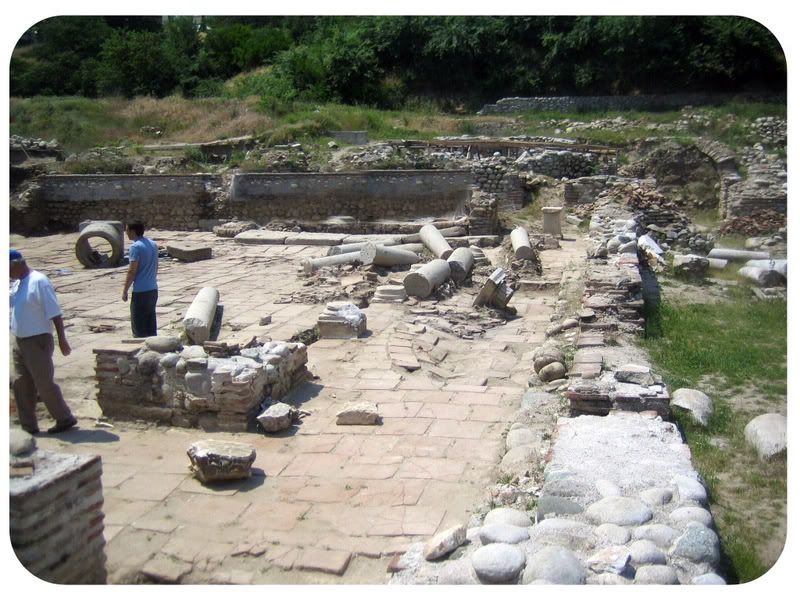Excavation and Fieldschool Opportunity in Israel
Follow in the Footsteps of David and Goliath: Dig Philistine Gath - The Tell es-Safi/Gath Archaeological Project
JULY 6 – August 1, 2008
The Site
Tell es-Safi/Gath (Hebrew Tel Tsafit), Israel, is a commanding mound located on the border between the Judean foothills (the Shephelah) and the coastal plain (Philistia), approximately halfway between Jerusalem and Ashkelon. At about 100 acres in size, it is one of the largest and most important pre-Classical period archaeological sites in Israel. Tell es-Safi is identified as Canaanite and Philistine Gath (known from the Bible as the home of Goliath and Achish) and Crusader Blanche Garde. The site was inhabited continuously from the Chalcolithic period (5th millennium BCE) until 1948 CE.
The Project
Since 1996 a team of archaeologists from the Institute of Archaeology at Bar Ilan University, under the direction of Prof. Aren M. Maeir, has been digging at Tell es-Safi/Gath. The first 12 years of the project (1996-2007) have demonstrated the great importance of the site. Major finds include: 1) A 9th century BCE destruction layer with extraordinarily rich remains; 2) An unique siege trench, dating to the Iron Age, that surrounds the site, apparent evidence of an Aramaic siege of the site (see II Kings 12:18); 3) A rich stratigraphic sequence covering the Early Bronze II through Modern times (ca. 26th BCE - 20th century CE); 4) A rich representation of the material culture of the Philistines, arch-enemies of the biblical-period Israelites; 5) Fascinating inscriptions from various periods, including Canaanite, Egyptian and Philistine (including the so-called “Goliath Inscription”).
The Program
All able and willing people between 16 and 80 are invited to join us for a unique and exciting experience uncovering the history and culture of the Holy Land. In addition to participating in all facets of the excavation process, participants will be provided with an opportunity to learn cutting-edge techniques of field archaeology, gain experience in archaeological science applications, hear lectures about the archaeology and history of the Land of Israel and related issues, and go on field trips to nearby sites of historical/archaeological and/or contemporary interest. Participants will join a young, vivacious team comprised of staff, students and volunteers from Israel and the world-over. Students can earn either 3 or 6 university credits through Bar-Ilan University, the second largest university in Israel. Accommodations (including kosher food) will be provided at idyllic Kibbutz Revadim, a short drive from the site. Rooms (4-6 per room; single and double rooms available at extra charge) are air-conditioned and there will be access to the Kibbutz pool. And don't forget the weekly, Thursday evening, Bar-B-Que!
WORKDAY (more or less)
6am to 1 pm excavation; Afternoon: various excavation related processes (such as pottery reading) and occasional tours; Evenings: occasional lectures.
We work Sunday afternoon to Friday mid-day.
Prices:
Volunteers: US$375 per week, 2 week minimum, or US$1450 for entire 4 weeks (plus US$50 registration fee). Price includes R&B for entire week, daily transportation to site and back, and various dig-related activities. Does not include transportation to Israel, and to and from the Base camp, as well as health and accident insurance.
Students (wishing to receive university credits): In addition to the R&B, $500 for half program (3 credits) and $1000 for full program (6 credits).
For application forms and further information, please contact:
Prof. Aren M. Maeir
The Institute of Archaeology
The Martin (Szusz) Department of Land of Israel Studies and Archaeology
Bar-Ilan University, Ramat Gan 52900
ISRAEL
Fax: ++972-3-6354941
Email: maeira@mail.biu.ac.il
Website: www.dig-gath.org
Blog: http://gath.wordpress.com





